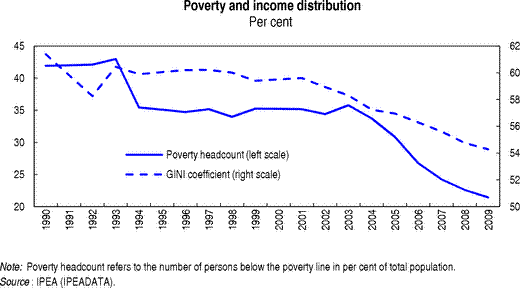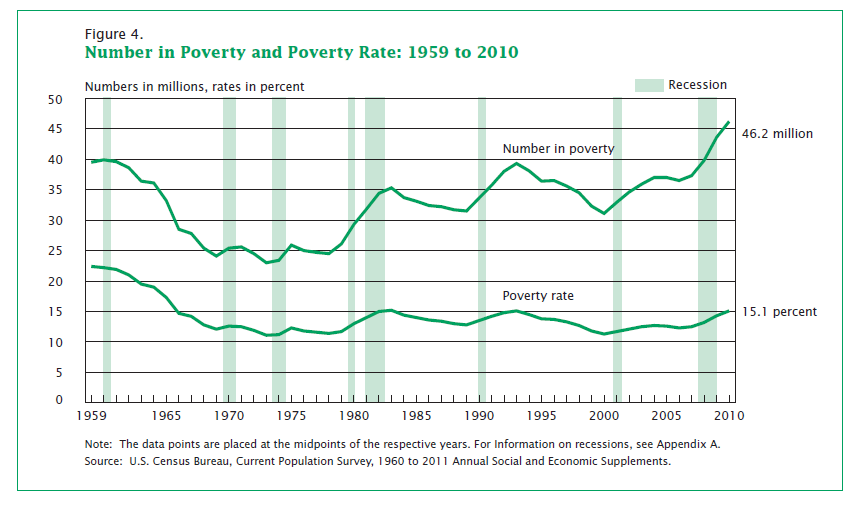The percentage of population living in poverty continues to decline in Brazil but is increasing in the U.S. in recent years.
The following chart shows the decline in poverty and income distribution in Brazil since 1990:
Click to enlarge
Source: Economic Survey of Brazil, OECD
The OECD report notes that the poverty rate has declined by half since 1993 and urges urges that the remarkable progress must be continued to further reduce high levels of inequality and poverty. According to OECD data, the number of people living below the poverty line declined from 42.98 million in 1993 to just 21.42 million in 2009.
Brazil is a developing country with a population of 203 million while the U.S. is an advanced economy with a population of 313 million.
The following chart shows the number of Americans living in poverty and the poverty rate from 1959 to 2010:
Click to enlarge
Source: U.S. Census Bureau
The sharp differences in poverty levels between Brazil and U.S. are shocking as displayed in the above graphs.
Since 2000, the number of people living in poverty in the U.S. has increased steadily to reach 46.2 million or about 15% of the total population. On the other hand, the number of Brazilians living in poverty stands at about 11% of the total population now.
On a related note, Forbes magazine’s “The World’s Billionaires” for 2011 lists 413 billionaires in the U.S. compared with 30 in Brazil. Forbes also laments that the U.S. is producing billionaires at a slower rate than in the past.
As more and more wealth is transferred into the hands of the top 1% of the U.S. population due to misguided government policies, the unfortunate among the rest of the 99% is further pushed into abject poverty. The social implications of this situation is huge as evidenced by the following report that appeared on the Real Time Economics blog of The Wall Street Journal on November 1, 2011:
Nearly 15% of the U.S. population relied on food stamps in August, as the number of recipients hit 45.8 million.
Food stamp rolls have risen 8.1% in the past year, the Department of Agriculture reported, though the pace of growth has slowed from the depths of the recession.
The number of recipients in the food stamp program, formally known as the Supplemental Nutrition Assistance Program (SNAP), may continue to rise in coming months as families continue to struggle with high unemployment and September’s data will likely include disaster assistance tied to the destruction and flooding caused by Hurricane Irene.
Almost the entire 46 million Americans currently living in poverty are dependent on the state for putting food on the table. This is astonishing since food prices are relatively much cheaper in the U.S. than other countries including most emerging countries.
Update #1:
From a news report released today:
The number of poor Americans hit a record 49 million in 2010, or 16%, according to new data released on Monday that showed poverty rates for the elderly, Asians and Hispanics higher than previously known.
The figures were calculated by the Census Bureau under a broad new measure intended to supplement the official standard with a fuller picture of poverty in the United States. Results contrast with official poverty data, released in September, that put the number of poor Americans at 46.2 million.
The biggest rise occurred among people aged 65 and older who are being driven into poverty by out-of-pocket medical expenses, including premiums and co-pays from the federal government’s Medicare program for the elderly.
Update #2:
From a Center on Budget and Policy Priorities report titled “Poverty and Financial Distress Would Have Been Substantially Worse in 2010 Without Government Action, New Census Data Show” :
Six temporary federal initiatives enacted in 2009 and 2010 to bolster the economy by lifting consumers’ incomes and purchases kept nearly 7 million Americans out of poverty in 2010, under an alternative measure of poverty that takes into account the impact of government benefit programs and taxes. These initiatives — three new or expanded tax credits, two enhancements of unemployment insurance, and an expansion of benefits through the Supplemental Nutrition Assistance Program (SNAP, formerly called food stamps) — were part of the 2009 Recovery Act. Congress subsequently extended or expanded some of them.
Hence the total number of persons in poverty would have been even higher last year if not for the six government initiatives.
Update #3: Brazil divided over an emerging middle class
From the BBC report:
Brazil’s economic success story has not only lifted millions of Brazilians out of poverty. It has also raised the expectations of a new lower-middle class – known here as the “C class”.





